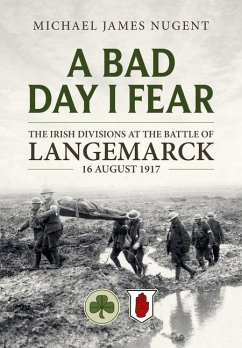The first detailed account of World War I's Battle of Langemarck from an Irish perspective. Having fought alongside each other with great success at the Battle of Messines (7-14 June 1917), the 16th (Irish) Division and 36th (Ulster) Division again fought side by side at the Battle of Langemarck (16 August 1917). On that occasion however, there was to be no success. Instead, an unmitigated disaster ensued resulting in the decimation of both divisions despite their tenacity and sacrifice. In A Bad Day I Fear: The Irish Divisions at the Battle of Langemarck, 16 August 1917, author Michael James Nugent investigates the causes of the failure to exploit the undoubted success of the Messines offensive which contributed to the delay between it and the opening of the Third Battle of Ypres. These were a general lack of urgency, misunderstandings and lack of clarity over assigned tactical objectives, mismanagement of artillery, tank and infantry assets and a failure to understand local geography. The unfortunate delay between the close of the Messines operations in mid-June 1917 and the opening of Third Ypres on 31 July enabled the German defenders to accelerate construction of reinforced ferro-concrete blockhouses and pillboxes that were to play an important role during the campaign. Their development and method of construction demonstrated the extent of the enemy defenses faced by the Irish divisions. The failure to break through the German defenses on 31 July led to the unplanned relief of XIX Corps' exhausted divisions by both Irish formations. This exchange ensured that 16th and 36th divisions held the front line under horrendous weather conditions and constant enemy shelling for two weeks prior to the 16th August attack. The result of this ordeal was weary and half-strength infantry battalions advancing to the assault at zero hour. This tragic affair is examined in detail from the perspective of each assault battalion by utilization of contemporary war diaries, personal accounts, official and regimental histories, enabling a coherent picture of the events of 16 August to be revealed for the first time. German sources are also employed as a means of presenting the 'other side of the hill' experience. Careful analysis of the severe manpower losses is included to emphasize the devastating consequences of a dreadful day that brought sorrow to many homes throughout Ireland. Finally, the controversial post-operation observations by General Sir Hubert Gough (GOC Fifth Army) concerning the performance of the Irish divisions are carefully analyzed to reach the determination that they were ill-advised and a poor attempt to deflect blame from the shortcomings of Fifth Army.
Hinweis: Dieser Artikel kann nur an eine deutsche Lieferadresse ausgeliefert werden.
Hinweis: Dieser Artikel kann nur an eine deutsche Lieferadresse ausgeliefert werden.








